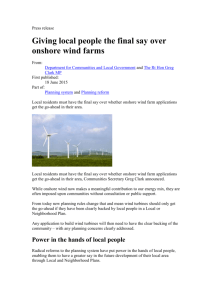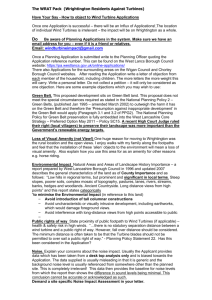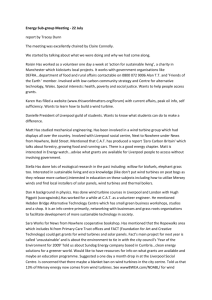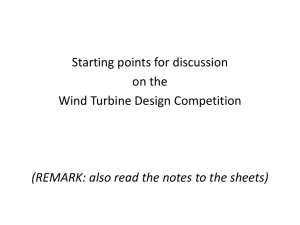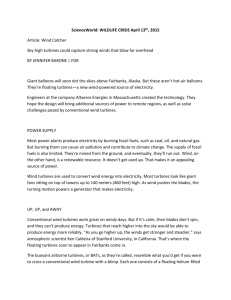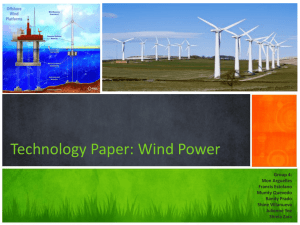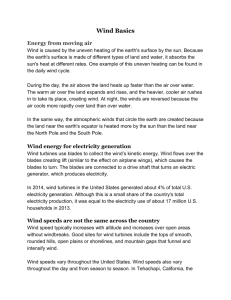Energy from Wind – the facts
advertisement
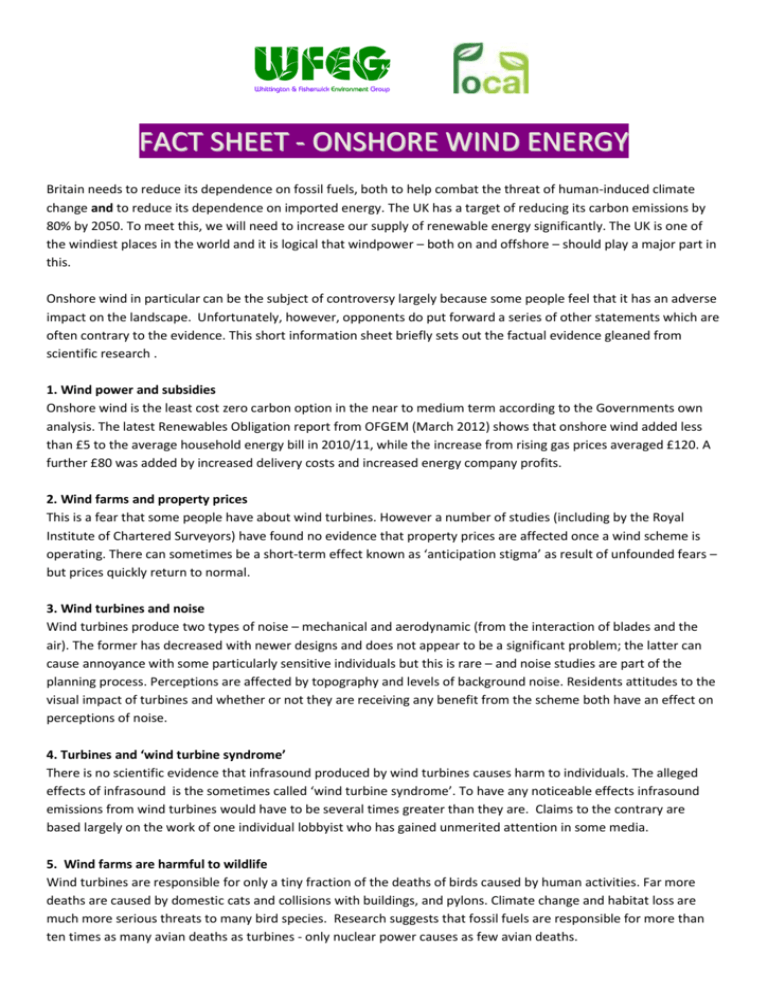
FACT SHEET - ONSHORE WIND ENERGY Britain needs to reduce its dependence on fossil fuels, both to help combat the threat of human-induced climate change and to reduce its dependence on imported energy. The UK has a target of reducing its carbon emissions by 80% by 2050. To meet this, we will need to increase our supply of renewable energy significantly. The UK is one of the windiest places in the world and it is logical that windpower – both on and offshore – should play a major part in this. Onshore wind in particular can be the subject of controversy largely because some people feel that it has an adverse impact on the landscape. Unfortunately, however, opponents do put forward a series of other statements which are often contrary to the evidence. This short information sheet briefly sets out the factual evidence gleaned from scientific research . 1. Wind power and subsidies Onshore wind is the least cost zero carbon option in the near to medium term according to the Governments own analysis. The latest Renewables Obligation report from OFGEM (March 2012) shows that onshore wind added less than £5 to the average household energy bill in 2010/11, while the increase from rising gas prices averaged £120. A further £80 was added by increased delivery costs and increased energy company profits. 2. Wind farms and property prices This is a fear that some people have about wind turbines. However a number of studies (including by the Royal Institute of Chartered Surveyors) have found no evidence that property prices are affected once a wind scheme is operating. There can sometimes be a short-term effect known as ‘anticipation stigma’ as result of unfounded fears – but prices quickly return to normal. 3. Wind turbines and noise Wind turbines produce two types of noise – mechanical and aerodynamic (from the interaction of blades and the air). The former has decreased with newer designs and does not appear to be a significant problem; the latter can cause annoyance with some particularly sensitive individuals but this is rare – and noise studies are part of the planning process. Perceptions are affected by topography and levels of background noise. Residents attitudes to the visual impact of turbines and whether or not they are receiving any benefit from the scheme both have an effect on perceptions of noise. 4. Turbines and ‘wind turbine syndrome’ There is no scientific evidence that infrasound produced by wind turbines causes harm to individuals. The alleged effects of infrasound is the sometimes called ‘wind turbine syndrome’. To have any noticeable effects infrasound emissions from wind turbines would have to be several times greater than they are. Claims to the contrary are based largely on the work of one individual lobbyist who has gained unmerited attention in some media. 5. Wind farms are harmful to wildlife Wind turbines are responsible for only a tiny fraction of the deaths of birds caused by human activities. Far more deaths are caused by domestic cats and collisions with buildings, and pylons. Climate change and habitat loss are much more serious threats to many bird species. Research suggests that fossil fuels are responsible for more than ten times as many avian deaths as turbines - only nuclear power causes as few avian deaths. 6. Intermittency of wind That the wind does not blow all the time is a truism. However the grid is well used to managing large fluctuations in demand for and supply of electric power. In addition wind speeds frequently vary across the UK and can also be helped by interconnections to Ireland and possibly also in the future to Iceland or the continent. Nevertheless a substantial increase in the proportion of the UK’s electricity generated from wind will require a certain amount of back-up capacity which has some cost attached but this is estimated to add only 5% to the cost of wind-generated electricity. 7. Efficiency of wind turbines It is sometimes alleged that wind turbines are inefficient and ‘only work 30% of the time’. This figure is based on the ‘load factor’ for onshore wind farms, but is erroneously used to imply wind power is inefficient. Wind farms actually generate electricity around 80–85% of the time, and power is converted to electricity very efficiently, with none of the thermal waste inherent in fossil fuel plants. Wind power is an efficient way to generate electricity, employing a free, renewable energy source. 8. Energy used in the construction of wind turbines Studies of a large number of turbines indicate that the average wind farm is expected to generate over its lifetime at least 20–25 times the energy required in its manufacture and installation. They also suggest that the average energy payback time for a wind farm is in the region of 3–6 months ie the length of time it takes to generate the amount of energy that was needed to make and install it. These figures compare favourably with other forms of power generation. 9. Shadow flicker As turbine blades move they may cause shadows on the ground or nearby dwellings to move, giving rise to a flicker effect through windows and doors. This only happens at certain times of day when the sun is low in the sky and the impact is not difficult to manage. This can be done, if necessary, by switching turbines off at certain times. ------------This fact sheet has been produced by Whittington and Fisherwick Environment Group (WFEG) on behalf of WFEG and Low Carbon Lichfield (LoCaL). For further information on WFEG please go to www.wfeg.org.uk. or email info@wfeg.org.uk. For more info on LoCaL, please visit www.lowcarbonlichfield.org.uk. WFEG would like to acknowledge the assistance of the Centre for Sustainable Energy and the helpfulness of its publication ‘Common Concerns about wind power’ which has provided much of the source material for this fact sheet. The publication can be downloaded from the CSE website www.cse.org.uk




